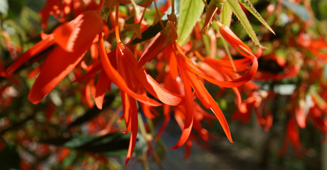

Contributor
- Topics: Archive

I was married in a borrowed brown suit on a gray Tuesday in January 1996. My bride wore a new brown dress. There is only one wedding photo of us. We are standing on the steps of the Renaissance loggia of the Kölner Rathaus, the city hall of Cologne just yards from where the Rhine cuts through the valley in which the city drowsed that morning. The light was grimy, not the best for photography, yet our smiles were bright. And my wife’s bouquet of twelve orange roses, and my boutonniere of one, glowed.
It was a rushed affair—though no shotguns were involved. My wife was a Lufthansa stewardess and was heading to colorful India shortly after noon, and I, to my shift cooking at a local restaurant. It was a modern marriage of convenience, no reception, and no honeymoon. The orange roses were our one extravagance.

Orange is extravagant, outrageous, and modern.
With orange, the most primary of the secondary colors (in my opinion), I begin the second half of our sojourn through color. Orange, the marriage of red and yellow, maintains both the primal force of red and the happy-go-lucky, child-like brightness of yellow.
Orange is not sexy—goofy, adolescent—but not innocent.

Maybe that is why it fares so poorly in popularity contests. As far as favorite colors go, orange lands at the bottom of the list, or sometimes just slightly above gray or brown. Garden designers label it as “harsh,” “the wild child,” or just “ too much.” P. Allen Smith says orange is “the rebel in the family, even more than its cousin red.” Possibly hinting at his role in the family, Smith is portrayed among orange tulips on the cover of his book, Colors for the Garden.
Rebellions are dangerous, and so is orange. Orange is tigers, poison frogs, and deadly arum berries.
Orange warns. It is traffic cones, barrels, and stanchions in construction zones and the clothing and hard hats of workers in those zones. Blaze orange keeps hunters from shooting each other and protects bicycle-commuters from the blindness of early morning drivers. Is it this link with modern danger that makes orange so unpopular? How can we not embrace an orange pumpkin, bite into a juicy ripe peach, or inhale the fragrance of a ‘Westerland’ rose in full bloom?

One of my clients insists orange is a color only for fall. I pussyfoot around color all year for her but I cannot stop her maples, katsuras, and sumacs from flaring with orange each fall. And she unabashedly loves it.
Orange is round, fecund, and boundless.
And orange needs to be put in its place. Whether that place is a season or a small container at the front door filled with Bonfire® begonias does not matter. “The most obvious way to use it is with other hot colors,” advises garden photographer Andrew Lawson.

The adventurous Christopher Lloyd, who considered orange “challenging,” advised using the hue boldly or not at all. “It is a waste to mingle it with red,” he warned, recommending pink, purple, and blue, its complement, as orange’s best garden betrothals.
One of my favorite pairings is orange flowers and silver foliage, a combination I accidently discovered after asking an assistant to plant some ‘Star of the East’ crocosmia bulbs randomly throughout a border. “Maybe I should have given more specific directions,” I thought the following spring when I saw crocosmia foliage poking through Artemisia ‘Valerie Finnis’.

Six years later, I have whipped this combination into a Big-Top froth bolstering the Artemisia with helichrysum and shrubby germander and adding ‘Sea Fuego’ dahlias and Bidens ‘Hawaiian Flare Orange Drop’ to keep the show going late into autumn when the neighboring sumac and smoke bush join the festivities.
And for good measure this year I added Salvia ‘Amistad’.
Orange may seem at home with its obvious companions and components red and yellow, but I find it most exiting when its hectic energy is both tempered and amplified by cool colors, in particular violet and purple, but also sky blue. The later preference likely comes from childhood autumns spent playing under the canopy of sugar maples and the blue October skies of Wisconsin.
Orange, though set aloft by the yellow in its make-up, is an earthy color. Brown and bronze lend weight to orange and make serious this clown of the color wheel. Terra cotta pots and bricks are orange, some say, at its grounded best.
There is also a melancholy to orange which, focused on its bossiness or comic stumbling through elegant planting designs, most garden writers don’t mention. Pumpkin days are happy, but they mark the end. We carve them in celebration of the dead not the living, making sinister faces to ward off spectral advances. And the glorious blaze of maple leaves comes just before the trees are laid bare for winter.

Orange is scary: Agent Orange, A Clockwork Orange.
Orange has a regal side evoking richness in scarlet, vermillion, and coral. The Tuscan palazzo I saw in Livorno last fall was painted a deep rich gold but in the last hour of light on that September day it burned with an imperial orange dignity. The Dalai Lama, a lover of laughter but no clown, often wears the orange robes of Theravada Buddhism as well as the more traditional maroon of his Tibetan Buddhism. Orange garlands India with ropes of marigolds draping Hindu temples, wedding feasts, and supermarket grand openings alike.
It is easy to focus on the exotic, especially with fruits like papaya, mango, and persimmon giving name to variations of the color. But orange is common too, like yellow. Nasturtium, calendula, and crocosmia are too easy and pesky in the garden. Here, the revered marigolds of India become cheap and ubiquitous in strip mall plantings, disgusting to my highbrow gardening friends but always a delight to me.
Orange also has an obedient side. Tempered with white it becomes delicious and inviting peach, apricot, and melon; gentle colors that smoothly unite with lavender, cream, and sliver. Yet these soft hues dauntlessly hold their own with pure violet, maroon, and even, might I suggest, true orange. These complex tints, slightly yellow, almost pink, are some of the most popular colors in gardens today.

Still, chances are, true orange is not your favorite color. Too brash, too cheap—too much! Whatever the reason, I encourage you to buy a bag of navel oranges this winter—our word for the color comes from this fruit; before the sixteenth century, English speakers called it simply red-yellow—and dump them into a big blue bowl on your kitchen table. Or, if you are feeling slightly extravagant, tuck a bouquet of orange roses into a brown crock or pin a single bloom on the lapel of a brown suit. I dare you not to enjoy the luminosity, happiness, and pure energy of orange.
Share:
Social Media
Garden Futurist Podcast
Most Popular
Videos
Topics
Related Posts

Low Maintenance Gardens – Better for Pollinators and People
Autumn 2022 “I come out every day. It’s therapy, my meditation.” Janet’s young garden transformed from overgrown, invasive plants to mostly natives. The dailiness of

Calochortophilia: A Californian’s Love Affair with a Genus
Summer 2022 I can chart the progression of my life by Calochortus. For the last two decades, at least. As a teenage girl growing up

Pacific Plant People: Carol Bornstein
Spring 2022 Public gardens play a key role in demonstrating naturalistic planting design, selecting native and adapted plants for habitat, and testing techniques for reducing

Add Year-Round Interest and Winter Blooms for Pollinators
Spring 2022 This article was created from an Interview by Merrill Jensen with Neil Bell in the Summer of 2021 for our Pacific Plant People










Responses